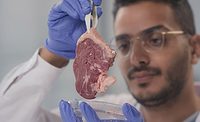IAFP 2022: Updates on Predictive Modeling for Meat, Poultry

Monday morning of the 2022 International Association for Food Protection (IAFP) Annual Meeting began with a session that explored the use of predictive modeling for meat and poultry food safety. “Recent Developments in Applications of Predictive Tools for Meat and Poultry Products” featured presentations by Dennis Seman, Ph.D., Adjunct Professor of Animal and Dairy Science at the University of Wisconsin; Panagiotis N. Skandamis, Ph.D., Professor of Food Microbiology, Food Hygiene, and Food Quality Control at the Agricultural University of Athens; and Lihan Huang, Ph.D., Research Leader of the Residue Chemistry and Predictive Microbiology Research Unit at the U.S. Department of Agriculture’s Agricultural Research Center’s (USDA’s ARS’) Eastern Regional Research Center.
The Usefulness of Predictive Modeling
Dr. Seman began with an overview of predictive microbiology in the food industry and what it may take to make the tool widely used. According to Dr. Seman, predictive modeling is a “tool that needs to be used appropriately” with practical applications and limitations. Predictive modeling can be useful to the food sector in generating information from microbial growth curves and how growth curves are affected by environmental factors. There are “off-the-shelf” models available to the meat industry for pathogens such as Listeria monocytogenes, Clostridium perfringens, and Staphylococcus aureus, but Dr. Seman stressed that it is important to remember that “off-the-shelf” models are not necessarily “one size fits all.”
Additional limitations and drawbacks of predictive modeling mentioned by Dr. Seman included the difficulty of translating the science and math of predictive models for people throughout industry; the time, financial, and training burdens of collecting the required data; the incongruence between estimates and reality; and the need for validation. Dr. Seman also shared the opinions of various industry professionals on the perceived barriers to the use of predictive modeling, revealing common themes such as the currently available “off-the-shelf” models not fitting all situations, as well as the fear of misuse or misapplication of models.
Despite the drawbacks, Dr. Seman explained that models can be useful for a wide range of applications, can provide an educated starting point for the development of new products, and can determine the possible consequences when deviations occur. Models are most useful when they come with guidelines for use, such as USDA’s Food Safety and Inspection Service (FSIS) provide for L. monocytogenes. In the future, Dr. Seman predicts that custom, proprietary models will be created and used by private companies to replace “off-the-shelf” models.
Using Predictive Models to Design Quality Products
Dr. Skandamis discussed the concept of “quality by design” and how predictive modeling can be leveraged to achieve product quality. He provided several examples of case studies to describe how food companies can use modeling to estimate what measures should be taken to design quality product formulations. Additionally, Dr. Skandamis explained the process by which food companies can combine predictive modeling with food safety objectives, performance criteria, and process criteria, as well as explained how to assess spoilage and food safety objectives in parallel with one another.
Dr. Skandamis also highlighted an innovative packaging technology that will be released soon. He is involved in the development of optical sensors based on organic LED lights that can evaluate the metabolic profile of a product and will change color when the product has spoiled.
USDA ARS Integrated Pathogen Modeling Platform
Finally, Dr. Huang provided an overview of USDA ARS’ new Integrated Pathogen Modeling Platform. The platform is an online application of predictive microbiology modeling tools that includes modules for model development. “I want to make sure anybody can do modeling,” Dr. Huang said, when describing the driving force behind the platform. The new platform is intended to provide industry with more accurate, fast, efficient, and useful models that are pre-validated.
The platform features four modules: model development, dynamic prediction of bacterial growth, dynamic prediction of bacterial inactivation, and growth versus no-growth boundary determination. The platform’s models differ from traditional predictive models in their science, using a One-Step Dynamic Analysis (OSDA) approach. OSDA enables more accurate tertiary models by combining primary and secondary models in a unique way. The platform also combines over 20 common models into one, as well as features advanced scientific computing libraries and standardized and unified model structures.
According to Dr. Huang, the platform minimizes and quantifies errors that occur during the modeling process and speeds up the model development process. He also emphasized that users of the platform do not need to know how to perform the complex calculations involved with predictive modeling—they only need to collect the required data and input.
The 2022 IAFP Annual Meeting is taking place July 31–August 3 in Pittsburgh, Pennsylvania.
Looking for a reprint of this article?
From high-res PDFs to custom plaques, order your copy today!






